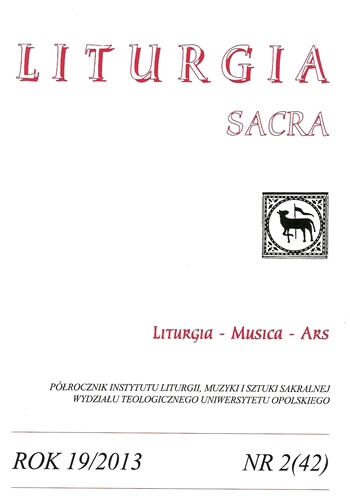Wyzwania soborowej reformy liturgicznej w ocenie Romano Guardiniego (1964)
Challenges of Conciliar Liturgical Reform in the Assessment of Romano Guardini (1964)
Author(s): Marcin WorbsSubject(s): Christian Theology and Religion, Theology and Religion
Published by: Uniwersytet Opolski
Keywords: Constitution on the Sacred Liturgy; Second Vatican Council; Romano Guardini
Summary/Abstract: Romano Guardini expressed his opinion about challenges of the conciliar, liturgical reform in his letter, Der Kultakt und die gegenwärtige Aufgabe der liturgischen Bildung, addressed to the participants of the Third Liturgical Congress in Mainz, in 1964. In this letter, the aged author points to significant problems, gives important impulses to the discussion, and determines the most urgent tasks, which had to be done after passing the Constitution on the Sacred Liturgy by the Second Vatican Council. Guardini is aware of the fact that in the new situation, it is necessary to tackle a number of detailed issues concerning the rite and liturgical texts, however, the question of the liturgical act is the most important task for him. He postulates to re-realise that the liturgical act is fulfilled by a man who is treated as a member of the community of the Church, and that in this act not only the spiritual inner being is activated, but the whole human being — a spirit and a body. It is also crucial to remember that the external human action is also a "prayer" — a religious act, and the circumstances that are included in this act, such as: time, place and used items are not only some exterior decoration, but they are its integral and essential elements, and as such, must be implemented. Moreover, it is crucial for the liturgy participant to see the deeper meaning in the activities performed in liturgy, as well as in the accepted, symbolic attitudes, i.e. to see the implementation of the liturgical act in them. Hence, Guardini emphasises the necessity for a solid liturgical formation, which besides teaching, must consist of authentic education in the liturgy. Furthermore, the problem of the so-called "ability to the liturgy" (Liturgiefähigkeit), which caused a lot of controversy, is also an important aspect of this Letter. The Guardini’s provocative question about the human ability to the liturgy should be understood not as disputing or casting doubts on the universal truth about the human ability to celebrate and experience the liturgy, but as a sign of deep concern for the activation of this ability for the most fruitful participation in sacred rites. Analysing letter, it is possible to come to the conclusion that Guardini could look deeply, widely and farther than many other early commentators of the conciliar, liturgical reform, who were interested only in the direct implementation of the Council’s provisions. Guardini, in his characteristic way, did not specifically concentrate on the issues, which dealt with headings, rites or liturgical agenda, but rather on fundamental challenges related to the adoption of the first conciliar constitution. His inspiring thoughts largely contributed to the transfer of the debate on the implementation of the conciliar, liturgical reform from the pure literary to the existential level.
Journal: Liturgia Sacra
- Issue Year: XIX/2013
- Issue No: 42
- Page Range: 289-300
- Page Count: 12
- Language: Polish
- Content File-PDF

